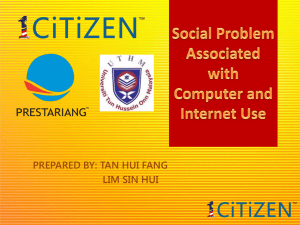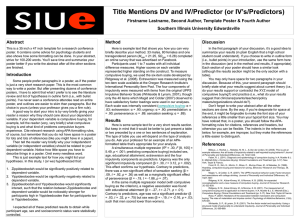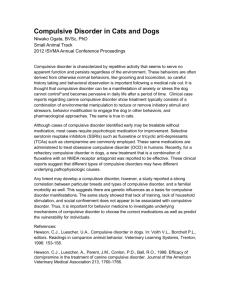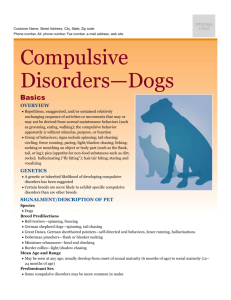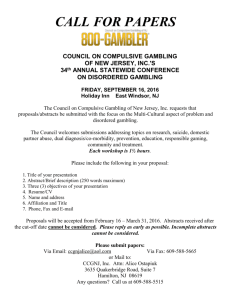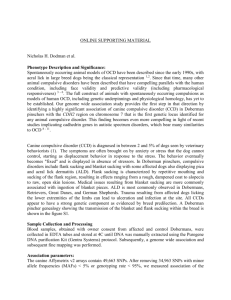factors influencing compulsive buying behavior: a
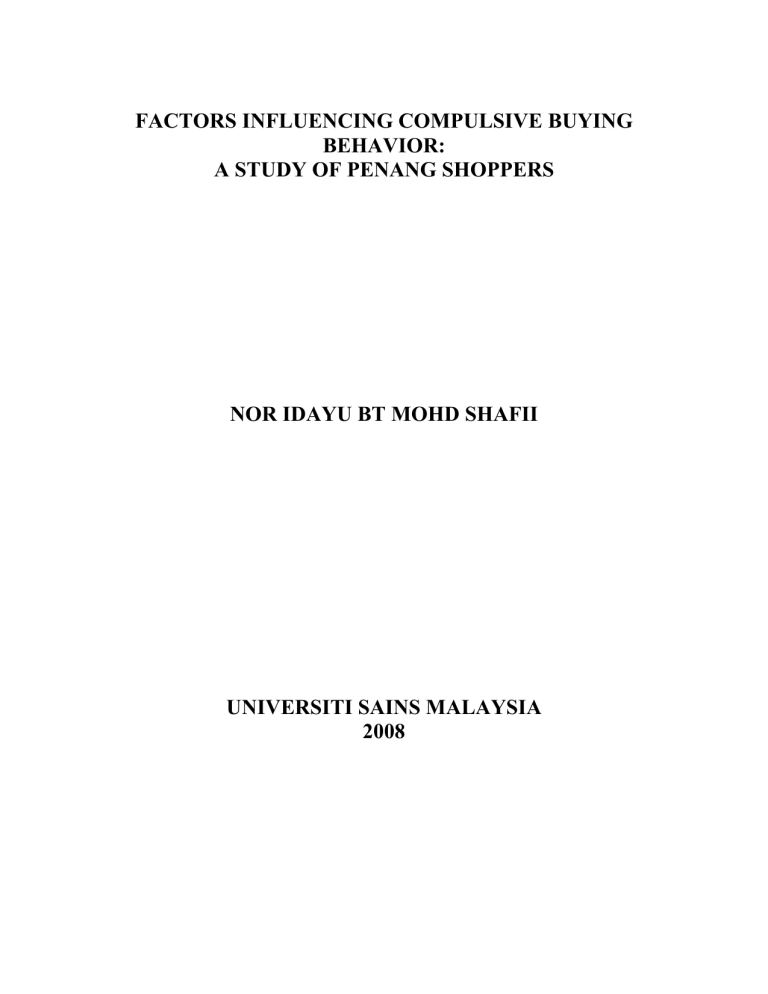
FACTORS INFLUENCING COMPULSIVE BUYING
BEHAVIOR:
A STUDY OF PENANG SHOPPERS
NOR IDAYU BT MOHD SHAFII
UNIVERSITI SAINS MALAYSIA
2008
TABLE OF CONTENTS
Title
Dedication
Acknowledgements
Table of Contents
Appendixes
List of Tables
List of Figures
Abstrak
Abstract
Chapter 1: Introduction
1.1 Introduction
1.2 Background
1.2.1 The Phenomena
1.2.2 Compulsive Buying Behavior
1.3 Problem Statement
1.4 Research Objective
1.5 Research Questions
1.6 Significance of the Study
1.7 Definitions of Key Terms
1.8 Organization of Remaining Chapters
Chapter 2: Literature Review
2.0 Introduction
2.1 Dependant Variable: Compulsive Purchase Tendency
2.2 Independent Variable: Marketing Stimuli (Price and Promotion)
2.2.1 Price
2.2.2 Sales Promotion
2.2.3 Independent Variable: External Factors (Credit Card)
2.2.4 Independent Variable: Psychological Trait (Self Esteem)
2.2.5 Independent Variable: Consumer Characteristics (Social /lifestyle)
2.3 Underlying Theory
2.4 Gaps in the Literature
2.5 Theoretical Framework
2.5.1 Hypothesis Development
2.6 Summary
Chapter 3: Methodology
3.0 Introduction
3.1 Research Design
3.2 Variables
3.3 Population and Sample
3.4 Sampling Design
17
18
20
21
21
22
23
24
12
12
15
16
16
25
25
25
26
27
8
10
7
7
4
7
1
1
1
3
Page viii ix x xi iii iv vii ii i
3.5 Data Collection Method
3.6 Questionnaire Design
3.7 Measurements of the Variables
3.8 Data Analysis
3.8.1 Data Preparation and Entry
3.9 Summary
Chapter 4: Result
4.0 Introduction
4.1 Demographic Profile of Respondents
4.2 Goodness of Measures
4.2.1 Factor Analysis
4.3 Restatement of Hypothesis
4.4 Reliability Instruments
4.5 Descriptive Statistics
4.6 Correlation Analysis
4.7 Discriminant Analysis
4.8 Multiple Regression Analysis
4.8.1 Compulsive Buyer
4.8.2 Non-compulsive Buyer
4.9 Hypothesis Testing
4.10 Summary of Results
Chapter 5: Discussion and Conclusion
5.0 Introduction
5.1 Recapitulation of the Findings
5.1.1 Factor Analysis
5.1.2 Discriminant Analysis
5.1.3 Multiple Regression Analysis
5.2 Discussion
5.2.1
Research Question 1: Do external factors such as marketing
(price, sales promotion) spur Compulsive Purchase Tendency?
5.2.2
Research question 2: Does credit card use encourage compulsive buying?
5.2.3
Research Question 3: Do consumers’ psychological trait (self-esteem) influence compulsive buying?
Research Question 4 : Do consumers’ characteristics (social/lifestyle) spur compulsive purchase tendency
5.3 Implications
5.3.1 Knowledge
5.3.2 Consumer
5.3.3 Marketer
5.3.4 Policy Maker
5.4 Limitations
5.5 Recommendations for Future Research
5.6 Conclusion
54
54
54
55
55
55
55
56
57
58
61
62
62
63
58
58
59
60
41
41
42
43
48
49
32
32
37
37
40
51
52
53
27
28
28
30
30
31
References
Appendixes
APPENDIX A: Cover Letter and Questionnaire
APPENDIX B: SPSS Analysis Output
B1: Frequency Table
B 2: Chi Square Analysis (Percentage of each item)
B 3: Factor Analysis
B 4: Reliability Analysis
B 5: Descriptive Statistics
B 6: Correlation Analysis
B 7: Discriminant Analysis
B 8: Multiple Regression Analysis
64
94
95
96
107
71
79
79
82
85
87
LIST OF TABLE
Table 3.0 The Measures and Layout of the Questionnaire
Table 4.1 Profile of Respondents
Table 4.1.2 I will buy clothes/apparel or jewelry every time I go out for shopping
Table 4.1.3 I shop for clothes/apparel or jewelry at least once a month
Table 4.2 Percentage Distribution of Compulsive and Non-Compulsive Buyers
Table 4.3 Results of the Factor Analysis
Table 4.4 Reliability Coefficients of the Independent Variables
Table 4.5 Descriptive Statistics for the Study Variables
Table 4.6 Pearson’s Correlations Coefficients of the Study Variables
Table 4.7 Hit Ratio for Cases Selected in the Analysis
Table 4.8 Hit Ratio For Cross Validation
Table 4.9 Hit Ratio for Cases in the Holdout Sample
Table 4.10 Comparison of Goodness of Results
Table 4.11 Hit Ratio for Cases Selected in the Analysis (Credit Card Use)
Table 4.12 Hit Ratio For Cross Validation (Credit Card Use)
Table 4.13 Hit Ratio for Cases in the Holdout Sample (Credit Card Use)
Table 4.14 Comparison of Goodness of Results (Credit Card Use)
Table 4.15 Summary of Interpretive Measures for Discriminant Analysis
Table 4.16 Mean Comparison of Non-compulsive and Compulsive Buyer
Table 4.17 Model Summary (compulsive Buyer)
Table 4.18 Regression Analysis: Enter Method (Compulsive Buyer)
Table 4.19 Regression Analysis: Stepwise Method (Compulsive Buyer)
Table 4.20 Model Summary
Table 4.21 Regression Analysis: Enter Method (Non-compulsive Buyer)
Table 4.22 Regression Analysis: Stepwise Method (Non-compulsive Buyer)
Table 4.23 Summary of all Hypotheses
Page
46
46
47
48
49
50
50
51
51
52
53
43
44
44
44
45
45
30
33
34
34
36
39
41
42
43
LIST OF FIGURES
Figure 2.0 Model of consumer behavior
Figure 2.1 Theory of reasoned action
Figure 2.2 Theoretical framework
Page
15
21
22
APPENDIXES
APPENDIX A: Cover Letter and Questionnaire
APPENDIX B: SPSS Analysis Output
B1: Frequency Table
B 2: Chi Square Analysis (Percentage of each item)
B 3: Factor Analysis
B 4: Reliability Analysis
B 5: Descriptive Statistics
B 6: Correlation Analysis
B 7: Discriminant Analysis
B 8: Multiple Regression Analysis
Page
71
79
79
82
85
87
94
95
96
107
ABSTRAK
OBSESI PERLAKUAN PEMBELIAN YANG MENDESAK
Obsesi perlakuan pembelian yang mendesak bukanlah sesuatu yang baru di Malaysia, tetapi hanya segelintir rakyat Malaysia yang tahu erti sebenar perlakuan ini. Obsesi perlakuan pembelian yang mendesak merupakan perlakuan yang kronik, pembelian secara berulangan di mana ianya mendorong kepada respon awal kepada perasaan yang negatif ( O’Quinn dan Faber,
1989). Setiap individu tidak mengira jantina, umur dan tahap sosial berkemungkinan menjadi mangsa kepada perlakuan ini. Oleh itu, kajian ini mengkaji faktor-faktor yang menyumbang ke arah kecenderungan kepada obsesi perlakuan pembelian yang mendesak di kalangan pembeli di
Pulau Pinang. 200 borang soal selidik berstruktur diedarkan di Universiti Sains Malaysia dan
Queensbay Mall Pulau Pinang. Untuk mencapai objektif kajian, lima hipotesis telah dibangunkan dan faktor-faktor ini; harga, promosi jualan, penggunaan kad kredit, penghargaan diri dan sosial/gaya hidup didapati mempunyai hubungan yang signifikan dengan kecenderungan kepada obsesi perlakuan pembelian yang mendesak. Kajian ini juga berjaya memisahkan faktor yang meyumbang ke arah ketidakcenderungan dan kecenderungan kepada obsesi perlakuan pembelian yang mendesak. Hasil kajian ini menyumbang kepada pengetahuan, pengguna, pemasar dan juga penggubal polisi.
ABSTRACT
COMPULSIVE BUYING BEHAVIOR
Compulsive buying behavior is not something new in Malaysia yet only small number of
Malaysians knows what compulsive buying really is. Compulsive buying is chronic, repetitive purchasing that becomes a primary response to negative events of feelings ( O’Quinn and Faber,
1989). Moreover everyone regardless their gender, age or social status may be the victim of compulsive buying. For that reason this study investigates the factors contributing to compulsive purchase tendency among shoppers in Penang. A total of 200 structured questionnaires were distributed in Universiti Sains Malaysia and Queensbay Mall Penang. In order to achieve the research objectives five hypothesis were developed and these factors; price, sales promotion, credit card use, self-esteem and social/lifestyle were found to have significant relationship with compulsive purchase tendency. This study also discriminates factors that contribute to noncompulsive and compulsive purchase tendency. The findings of the research contribute to the knowledge, customers, the marketer as well as the policy maker.
CHAPTER 1
INTRODUCTION
1.1
Introduction
This chapter illustrates the background of the study, problem statement, objective, research questions and the significance of the research.
1.2
Background
The background present the phenomena of unplanned, impulse and compulsive buying behavior that being encouraged by the existence of shopping malls and credit facilities.
Malaysia is one of the fastest developing countries in the world. The country’s economy is expanding and the government is trying their best to upgrade the citizen’s quality of life. However, the Department of Statistics Malaysia indicated that Consumer Price Index
(CPI) for January to March 2008 increased by 2.6 per cent to 107.8 compared with the same period last year. This shows that consumer buying power is decreasing as most of the products sold in Malaysia are blowing up. Therefore the price rising don’t seem to affect some consumers because based on a poll that are conducted by TV3 through Buletin Utama on 5 May 2008, 64% viewers agrees that Malaysian like to waste money and spend extravagantly .
Compulsive buying disorder occurs mainly in developed countries. The presence of a market-based economy, the availability of a wide variety of goods, easily
1
obtained credit, disposable income and significant leisure time appear necessary for the development of compulsive buying behavior (Black DW, 2007).
The ACNielson survey’s report (14 June 2006) about consumers’ attitudes towards shopping confirmed that the world’s biggest shopaholics are to be found in Asia. The result shows that 34% of Malaysians shop at least once a month as a form of entertainment and 5% of them shop twice a week for the same reason. Whereas 25% of consumers use shopping as
‘something to do’ once a week, 18% think that shopping is considered therapeutic while 14% deemed shopping as a favorable thing to do. Shopping has become a national pastime in many
Asians countries. This is because many shopping malls have been designed and have become entertainment destinations incorporating cinemas, restaurants, food courts, additional sports and entertainment facilities to suit all budget. The place has become a one-stop centre for all age.
The escalation of hypermarkets and shopping complexes in Malaysia is undeniable.
Producers are enthusiastic to come out with something new such as futuristic clothes and multipurpose hand phones, whereas marketers are keen to make sure that those products can be sold and gain higher returns. They will use many kinds of strategies and tactics to attain customer’s attention. One of the famous strategies is sales promotion. Sales have become a main agenda for many shopping malls in Malaysia. There are posters and banners everywhere during the sales period, advertising bursting in the radio and television in order to attract local and foreign customers. The tactics really catch the customer’s attention as it is common to see
Malaysian swarming the shopping complexes during that period.
Besides the persuasion from the marketers, financial institution is taking advantage of tempted consumer who can’t afford to shop. They offer various types of credit cards to these customers and charge high interest for it. These scenarios may be the reasons for consumers
2
to shop more especially in big cities like Kuala Lumpur, Johor Bahru and Penang. The fact that in Malaysia, 40% of fresh graduates ran into financial difficulties due to credit card debt
(The Star 22 October 2007) doesn’t affect the shopping habit. Credit card usage is booming throughout the years. It seems like it is a fast track in solving financial problem but the fact is huge number of people worldwide are trapped in the most expensive legal form of consumer debt.
1.2.2 Compulsive Buying Behavior
The fast moving expansion in many areas shows a good sign of economic growth for
Malaysia and ultimately will have a positive impact towards foreign direct investment as well as tourism industry. On the other hand, this scenario may promote unplanned, impulse and compulsive buying behavior. There are distinct differences between these behaviors and most likely it may happen to anybody.
According to O’Quinn and Faber (1989), unplanned buying occurs when consumer is unfamiliar with the store’s layout, they have limited time to shop, or is reminded of the need to buy an item when seeing it on the shelf. In contrast impulse buying is an outcome of a sudden consumer’s irresistible urge to buy an item spontaneously. However, compulsive buying happens when a consumer is facing repetitive shopping addiction at time excessive, because of boredom, tension or anxiety (Shoham and Brencic, 2003). Two main criteria for compulsive buying are the behavior must be repetitive and must be problematic for the individual (O’Guinn and Faber, 1989).
People who have compulsive buying disorder are often struck with an irresistible, intrusive and often senseless impulse to buy. It is common for sufferers to go on frequent
3
shopping and to accumulate large quantities of unwanted items. They often rack thousands of dollars in debt and lie to their loved ones about their purchases (Science Daily Oct 6, 2006).
Compulsive shoppers feel low when they're not out shopping, and crave for that special
"high" that comes from browsing and buying (New York Times, Sept. 28, 2005). The Web
MD Medical News (Oct 2, 2006), reported that compulsive buying lead to bankruptcy, divorce, embezzlement, even suicide attempts.
As a consumer the researcher is interested to study this phenomenon as she observes that at times the researcher feels that she cannot resist the temptation of shopping. The researcher might not be alone in this case. These negative consumption phenomena are worth to study so that consumers and the researcher herself can understand more about these behaviors.
1.3
Problem Statement
The shopping phenomenon is attacking the country. Malaysia was rank number four among the highest in the world for shopping twice a week for entertainment after Hong Kong,
Thailand and Singapore (AcNielson, 2006). As mentioned before a poll that is conducted by
TV3 through Buletin Utama showed that 64% viewers agree that Malaysian like to waste money and spend extravagantly. Surveys by AcNielson (2006) also confirmed that the world’s biggest shopaholics are to be found in Asia and nearly half of Malaysian likes to shop.
The dark side of shopping is compulsive buying. As highlighted earlier Malaysian consumers are vulnerable and easily drawn to compulsive buying, yet there are lacks of research in
Malaysian context about it.
4
There are a number of empirical researches (e.g., Kwak, Zinkhan, and Roushanzamir,
2004, O’Guinn and Faber 1989) about compulsive buying behavior that have been conducted before but most of them are mainly from the western perspective. What drives consumer to shop? What makes some Malaysian become shopaholics? In response to the problem this research will seek for the answers for those questions. As previous study are focusing on the consumers demographic determinants only this research will look into the factors contributing to compulsive buying, that is marketing stimuli, consumer’s psychological traits and consumer’s characteristics.
The four components of marketing which are product, price, place and promotions definitely will have an impact in purchase decision. But what type of product that usually compulsive buyers crave on? According to the AC Nielson news (June 14, 2006) about
Malaysians shopping behavior, usually female will go for clothes, cosmetics, jewelries and home articles. Whereas men will go for clothes, tools, gadgets, CD’s, books, cameras and computer stuff. Schlosser et al.
(2001) stated that favorite categories for items purchased by compulsive shoppers include clothing, shoes, jewelry, make-up, and compact discs. So for the purpose of this research we will look more into apparels and accessories as both male and female shared the same interest on it.
The best place to shop is the shopping malls. As mentioned above shopping malls is a one stop destination where customers can do anything under one roof. The setting of the shopping mall will attract more customers to spend more time and money there. Since previous research has shown the significance of product and place with compulsive buyers, this research will look into the relationship of marketing stimuli (price and promotion) to compulsive purchase tendency.
5
There are many sales events held in the shopping malls in a year. Sales promotion such as Mega Sale, Members Day Sales and Year End Sale (YES) were happening as frequent as once a month. Although these events give consumers the opportunity to buy things at discounted price, the products on sale are not necessarily cheap. Do customers aware of the marketer’s strategy? Do they feel cheated? This study will try to answer these questions.
Product variation and price competition are good for consumers but in some way it will induce them to buy unnecessary things.
Credit card is another factor that is related with shopping habit. The dramatic increase of credit card use in recent years by Malaysian consumers has accelerated the consumption habit in them. This research will investigate the impact of credit card usage towards compulsive buying. Besides external stimuli, does internal factors such as consumer’s psychological trait and consumer characteristic plays a great role in compulsive purchase tendency? There is lack of empirical research to prove this. Marketers need to understand such consumer behavior in order to formulate appropriate marketing strategy, allocate marketing resources and design effective marketing tactics. Compulsive buying behavior has recently received long overdue attention as a clinical issue . Thus i t is important for the consumers to understand about this because they might be the victim of compulsive buying behavior without realizing it.
Based on the insights, there is a need to examine the phenomena of compulsive buying behavior in the Malaysian context. The present study has selected price/sales promotion, credit card use, self-esteem and social/lifestyle to be examined as the factors contributing to compulsive purchase tendency.
6
1.4
Research Objective
Objective of the research is to investigate the factors contributing to compulsive purchase tendency in Malaysia. The factors that are studied in the present study are price/sales promotion, credit card use, self-esteem and social/lifestyle. This research will focus on shopping malls buying behavior.
1.5
Research Questions
In order to achieve the above objectives, the study will try to answer the following questions:
1.
Do external factors such as marketing (price, promotion) spur compulsive buying?
2.
Does credit card use encourage compulsive buying?
3.
Do consumers’ psychological traits (self esteem) influence compulsive buying?
4.
Do consumers’ characteristics (social, lifestyle) spur compulsive buying?
1.6
Significance of the Study
The study is to investigate the factors contributing to compulsive purchase tendency in the context of Malaysian market. There are many factors that can influence compulsive purchase tendency. However this study will focus on the impact of marketing stimuli (price and promotion), credit card usage, consumer psychological traits (self esteem) and consumer characteristics (social) towards compulsive purchase tendency.
This study is important because most Malaysian especially in big city is facing either unplanned buying or impulse buying or worst, compulsive buying behavior. The findings will benefit consumer, marketers and the government as a whole. It can help the consumer to better understand the internal and external factors that leads to compulsive buying. On the other hand, this research can provide potential guideline to policy makers about how to
7
combat compulsive buying behavior and reduce its impact. As for marketers, this study will help them to better understand the consumer in order to develop their marketing strategies.
Finally, the findings of the study aim to expand the research areas in the context of
Malaysian market. It is hoped that this findings will improve consumer awareness towards compulsive buying and at the same time will help marketers to more appreciate the dynamics of consumer behavior in order to act ethically when promoting products that have potential to create additive or compulsive behavior.
1.7
Definitions of Key Terms
For the purpose of this study, the following definitions were referred to specifically.
• Compulsive Buying
According to O’Quinn and Faber (1989), compulsive buying is chronic, repetitive purchasing that becomes a primary response to negative events of feelings.
• Impulse
Impulse is a sudden wish or urge that prompts an unpremeditated act or feeling; an abrupt inclination (http://www.thefreedictionary.com).
• Impulse Buying
Impulse buying is an outcome of a sudden consumer’s irresistible urge to buy an item spontaneously (O’Quinn and Faber, 1989). It centers on specific product at a particular moment, and it is temporary (Park and Burns, 2005 quote Solomon, 2004).
8
• Marketing
Marketing is a process of planning and executing the conception, pricing, promotion, and distribution of ideas, goods and services to create exchanges that satisfy individual and organizational goals (Kotler and Kettler. 2006, p.5).
• Sales Promotion
Sales promotion consist of a collection of incentives tools, mostly short term, designed to stimulate quicker or greater purchase of particular products or services by consumers or the trade (Kotler and Kettler. 2006, p.543).
• Self esteem
Self-esteem reflects a person's overall self-appraisal of their own worth ( Oxford English
Dictionary ). It involves reputation or prestige, status, recognition, attention and appreciation (Mullins, 2005).
• Lifestyle
Lifestyle is a person’s pattern of living in the world as expressed in activities, interests and opinions (Kotler and Kettler. 2006, p.173).
• Credit Card
Credit card is a plastic card having a magnetic strip, issued by a bank or business authorizing the holder to buy goods or services on credit, also called charge card
( www.thefreedictionary.com
).
9
• Credit Card Use
A credit card allows consumers to purchase products or services without cash and to pay for them at a later date. They then receive a line of credit with a specified dollar amount.
They can use the card to make purchases from participating merchants until they reach this credit limit. Every month the sponsor provides a bill, which tallies the card activity during the previous 30 days. Depending on the terms of the card, the customer may pay interest charges on the amount that they do not pay for on a monthly basis
(www.anwers.com).
• Advertising
Any paid form of nonpersonal presentation and promotion of ideas, goods, or services by an identified sponsor (Kotler and Kettler. 2006, p.526).
1.8
Organization of Remaining Chapters
• Chapter 1 : The first chapter being the introduction. It reviews the purpose of the study and the research objectives as a guide for the whole study. The significance of the study is addressed to provide readers the purpose of conducting the study.
• Chapter 2 : This chapter reviews past literatures which are relative to the study currently undertaken.
• Chapter 3 : This chapter illustrates the methodology used in the present study. It discusses the design, variables, sample, procedure, measures and data analysis.
• Chapter 4 : This chapter presents the results of the statistical analysis for the data collected as well as the findings encapsulated from the analysis.
10
• Chapter 5 : Finally, this chapter provides discussions and implications of the present study findings. This chapter also provides the practical implications of the study to the consumer, the marketer and not to forget the policy maker. The limitations of the study and recommendations for future research are provided.
11
CHAPTER 2
LITERITURE REVIEW
2.0 Introduction
This chapter reviews the scholarly literature relevant to the topic of the study. It contains reviews of past and present studies about compulsive buying behavior. The highlight here is to see what compulsive behavior really is and the factors contributing to it.
Shopping has become a national pastime in many Asians countries. As for Malaysian, most of the consumers perceived shopping as ‘retail therapy’, they feel shopping as an activity to relief stress, some of them use shopping as ‘something to do’ once a week. Therefore, the impact of shopping is enormous towards Malaysian consumer. Shopping activity is not a sin but addiction to shopping is not right. It will lead to compulsive buying tendency and other negative behaviors.
2.1 Dependant Variable: Compulsive Purchase Tendency
Compulsive buying has been defined as a “chronic, repetitive purchasing that becomes a primary response to negative events or feeling” (Shoham and Brencic, 2003; O’Quinn and
Faber, 1992). It refers to consumers’ repetitive shopping, at time excessive, happened because of boredom, tension or anxiety (Shoham and Brencic, 2003; Solomon 2002). Compulsive buyers tend to buy excessive number of objects they do not need and they sometimes cannot afford (Hoyer and MacInnis, 2001). It is an enduring behaviour that focuses on the process of buying, not the purchase themselves (Solomon, 2004). The characteristic of a compulsive buyer varies but usually they took greater pleasure in shopping and buying. They often made
12
“senseless and impulsive purchases”, they often felt depressed after shopping and they are more often experienced uncontrollable buying binges (Koran, 2006).
Compulsive buying is one form of compulsive consumption that is the realm of abnormal consumer behavior regarded as the dark side of consumption (Park and Burns,
2005; Shiffman and Kanuk, 2000) . It is inappropriate, typically excessive, and clearly destructive to the lives of individuals who appear impulsively driven to consume (Kwak and
Roushanzamir, 2004; Faber et al.,
1987).
Usually compulsive buyer felt the product “calling” them, almost demanding them to purchase it, (Hausman, 2000; Rook 1987).
Compulsive buying disorder is characterized by excessive or poorly controlled preoccupations, urges, or behaviors regarding shopping and spending that lead to subjective distress or impaired functioning (Black, 2007).
Gender was a significant predictor of compulsivity. Shoham and Brencic (2003) conducted a research concerning the relationship of gender and compulsive buying. Before the research was conducted they assume that women will exhibit lower levels of compulsive purchase tendencies. The assumption was based on this aspect; traditionally women are in charge in grocery shopping, so they are more likely to plan their purchases. Generally consumers who plan their purchases will exhibit lower tendency for compulsive buying
(Shoham and Berncic, 2003; Block and Morwitz, 1999). After the research was conducted they found out that female were more likely to exhibit a tendency for compulsive buying. In clinical settings, approximately 80% of individuals with compulsive buying disorder are women (Black, 2007) therefore, Shoham and Brencic (2003) stated that although the tendency among women is higher than men but everybody regardless their gender, age and social status faced compulsive buying behavior problem.
13
Genetic evidence also supports the finding that people suffering from compulsive buying behavior are likely to have other impulse disorders such as pathological gambling (an urge to gamble despite harmful negative consequences or a desire to stop), substance abuse and eating disorders, and/or have relatives with impulse control disorders (Kwak, Zinkhan, and Roushanzamir, 2004; Faber et. al
., 1995; Valence et al
., 1998).
Many researchers found out that this negative behavior is caused by personal and social effect. In psychiatry, usually a compulsive buyer simultaneously exhibits other compulsive behaviors, a phenomenon that has been called “comorbidity” (Kwak, Zinkhan, and Roushanzamir, 2004). Comorbidity is defined as coexistence of multiple compulsive behaviors (Kwak and Roushanzamir, (2004); Faber et al.,
1995; McElroy et al.,
1991;
Valence et al.,
1998) . These behaviors will results to other negative habits such as alcohol use and gambling.
Compulsive buying consists of three core features: a) the impulse to buy is experienced as irresistible, b) individuals lose control over their buying behavior, and c) they continue with excessive buying despite adverse consequences in their personal, social, or occupational lives and financial debt (Dittmar, 2004).
Compulsive buyer can be separated from everyone else by using screening instrument, the Compulsive Buying Scale (CBS) created by Valence, d’Astous and Fotier (1989). It consists of thirteen items derived from previous research and theoretical models of compulsive buying. Subject will be ask to rate how true each item was for them on a scale range from 1 to 5, (Faber and O’Guinn, 1992).
14
Figure 2.0 Model of consumer behavior
Source:
Kotler and Kettler (2006)
As shown in Figure 2, consumer buying behaviour is depending on few factors. It is a set of psychological process combine with certain consumer characteristics to result in decision process and purchase decisions (Kotler and Kettler, 2006, p.174). The next section will discuss the different factors contributing to compulsive buying behavior. These factors were selected from the components of external stimuli (marketing and other stimuli), consumer psychology and consumer characteristics as of the model of consumer behavior.
2.2 Independent Variable: Marketing Stimuli (Price and Promotion)
Marketing deals with identifying and meeting human and social needs. It is a process of planning and executing the conception, pricing, promotion, and distribution of ideas, goods and services to create exchanges that satisfy individual and organizational goals (Kotler and
Kettler. 2006, p.5).
15
2.2.1 Price
The second important component of marketing is price. Price is t he quantity of payment or compensation for something. Bayler (1998) and Narasimhan et. al.
(1996) said that price-related promotions might not always be the answer to high impulse categories. But
Cobb and Hoyer (1996) noted that low price product is more likely to be bought on impulse.
Previous researcher found out that compulsive buying is the next stage of impulse buying. If price has an impact to impulsive buying it may have impact to compulsive buying as well.
According to Black (1994), shopping may occur in just about any venue, ranging from high-end department stores and boutiques to consignment shops or garage sales. The statement shows that compulsive buyer don’t even bother where they shop or how much the product cost as long as they can fulfill their desire.
Another component of marketing is promotion. There any many types of promotion but this study will emphasize on sales promotion. Sales promotion consist of a collection of incentives tools, mostly short term, designed to stimulate quicker or greater purchase of particular products or services by consumers or the trade (Kotler and Kettler. 2006, p.526,
543).
Compulsive buyer usually buy product based on the attractiveness or because it was a bargain. The items tend not to be large or particularly expensive, but many will buy in quantity so that spending gets out of hand (Black, 1994). But after conducting a research,
Black et al., (
2007), found out that compulsive buyer with lower gross income are spending only small portion of their income on sale items. They usually buy normal price products and
16
don’t wait until promotion period. They have little ability to control or to delay their urges to make inappropriate purchases.
Many people who suffer from compulsive shopping addiction can't pass up a good deal. They search the newspapers for announcements of sales and promotions so they won't miss out on bargains (Leong, 2007).
2.2.3 Independent Variable: External Factors (Credit Card)
As mentioned before compulsive buyers tend to buy excessive number of objects they do not need and they sometimes cannot afford (Park and Burns, 2005; Hoyer and MacInnis,
2001). If a person is a compulsive buyer and he or she can’t afford to buy things, what will he or she do? This is one of the reasons why credit cards came into the picture. Credit card is a plastic card having a magnetic strip, issued by a bank or business authorizing the holder to buy goods or service on credit. Sometimes it is called charged card.
(www.thefreedictionary.com).
Credit cards were design to help consumers to have an ease of purchase by not carrying big amount of cash and payment flexibility. But what happened today is consumers tend to use credit cards beyond their paying ability. The excessive amounts of promotion from credit cards provider worsen this scenario. Competition among provider is fierce so they are targeting everybody. They make it easier for consumer to apply for one and sometimes you don’t even need to apply, you are exclusively entitled to receive one. Due to the convenience of having and using credit cards compulsive buyer may think that money is not an issue as long as they can fulfill their addiction. The easy availability of credit and the material focus of society in general encourage people to accumulate possessions now and worry about financial
17
responsibility later. Those who had credit cards were much less likely to turn to any other sources of financing to get money for impulse or planned purchases (Sybrowsky 2007).
Several studies identified a significant relationship between credit card use and compulsive buying. According to Park and Burns (2005) credit card use was the most influential factor followed by expenditure on fashion goods to television home shopper’s compulsive buying. Compulsive buyer usually will have not more than USD500 of their credit card limits and just made their minimum card payment (Hitti, 2006). d’Astous (1990) found that the extent of irrational credit card usage was strongly associated with compulsive buying.
2.2.4 Independent Variable: Psychological Trait (Self Esteem)
Traditionally self-esteem has been defined as a global, personal judgment of one’s own worth. But now, the best explanation’s for self-esteem is based on theoretical distinction between self-esteem derived from positive regard from one’s social environment and selfesteem derived from assessment of one’s own abilities (Silvera et. al.
2008)
O’Guinn and Faber (1989) found that self-esteem is negatively related to compulsive buying behavior. The later research (Faber and O’Guinn 1992) also conducted by them shows that compulsive consumption is closely related to self-esteem. Compulsive buyer tends to have a higher level of adverse self-awareness, and low self-esteem is found to be an antecedent to compulsive buying (d’Astous 1990; Hanley and Wilhelm 1992). People who pursue self-esteem through compulsive consumption do not strive for self-esteem based on self-competency; rather they try to boost self-esteem by obtaining symbolic prestige conferred by others (Crocker and Wolfe, 2001).
18
Despite the fact that there are important differences between compulsive buying and impulse buying (Rook, 1987), these two phenomena share the central feature of losing impulse control while shopping. Thus, O’Guinn and Faber’s (1989) results are consistent with the proposition that impulse buying might serve as an escape from negative psychological states such as low self-esteem (Silvera et. al.,
2008).
Previous research has shown that compulsive buyers have lower self-esteem, a higher level of tendency to fantasize, higher of depression, anxiety and obsession compared to other consumers (Shoham and Brencic, 2003; Scherhorn et al.,
1990). Compulsive buyers are likely to be very conscious of how they look and appears to others and to be engaged in an unceasing pursuit of things (Krugger, 1998).
Elliot (1994) found out that one of the primary functions of compulsive buying is to increase the compulsive buyer’s ability to match his or her subjective perceptions of socially desirable or required appearance. Krugger (1998) support this assumption. He found out that compulsive buyer shops to fill internal emptiness and to make them feel complete.
Shopping is not only to procure necessary or desired product, but also to participate in a wide range of experiential activities in order to satisfy various personal and social motive
(Bloch, Ridgway, and Dawson 1994). Acquiring the “object” is not just a financial transaction but also at some level is also a cultural or personal endorsement. Compulsive buyer felt that to return home empty handed is to experience a sense of loss of self-esteem and a weakening of their ability to stay apace of contemporary society.
19
2.2.5 Independent Variable: Consumer Characteristics (Social /lifestyle)
Bayley, (1998); Dittmar et al., (1995) argue that some consumers buy goods that offer them “material symbols of personal and social identity”. A propensity to impulse buy will be at its strongest when there is a perceived self discrepancy between the actual self and the ideal self on the most important attributes to that person. They felt responsible to avoid being disadvantaged by being left behind. Previous research (Silvera et. al.,
2008; Bearden et al.
,
1989) found that consumers do think of other people’s perception when making purchase decision.
According to Dittmar et al.,
2007, there are internal and external pressures contributing to compulsive buying. For example, maintenance of a lifestyle equal to peers, relatives or society, or maintaining an identity or image that is deemed socially acceptable put a great pressure to compulsive buyer. Although the pressure comes from within but the source of the pressure usually comes from the outside. The lifestyle pressures of maintaining or seeking a better identity and positive emotions are likely to be linked to an underlying belief structure that places a strong emphasis on money and material goods. Materialism is a symbol to achieve important life goals, such as life satisfaction, happiness, and success.
The CSII (consumer susceptibility to interpersonal influence) scale was used to measure the extent to which an individual’s consumer choices are influenced by other people.
The Normative Components of CSII measures an individual’s tendency need to use purchases to identify with, or enhance his image on the eye of significant others, and a willingness to conform to the expectations of others in making purchase decisions (Bearden, Netemeyer and
Teel (1989).
20
The present study used theory of reasoned action as the foundation for the research .
TRA proposed that a person’s behavior is determined by his/her attention to perform the behavior and the attention will be a function of his/her attitude toward the behavior and his/her subjective norms (Fishbein and Ajzen, 1980). Figure 2.1 shows the diagram of theory of reasoned action. Beliefs towards an outcome and evaluation of the outcome will lead to attitude. The components of attitude include belief towards price, sales promotion and credit card use. For example a customer may believe that if the price is high the product quality is good. Meanwhile beliefs of what others think and motivation to comply with others will lead to subjective norms. Thus, self-esteem and lifestyle are the subjective norms. These factors will contribute to the intention behavior namely compulsive purchase tendency.
Attitude
Intention Behavior
Subjective Norms
Figure 2.1
Theory of reasoned action.
2.4 Gaps in the Literature
Previous studies (e.g. O’Guinn and Faber’s, 1989, Dittmar et al.,
2007, Shoham and
Brencic, 2003), have discussed about compulsive buying behavior and the factors contributing to it. However, so far there is no research being conducted that discusses all the
21
factors (attitude towards price, sales promotion, credit card use, self-esteem and social/lifestyle) as independent variables towards compulsive purchase tendency as a whole.
2.5 Theoretical
The key constructs in the model are shown in
Figure 2.2.
The theoretical framework examines the relationship between marketing stimuli (price, sales promotion), credit card use, self-esteem and life style towards compulsive purchase tendency.
External Stimuli
• Price
• Sales Promotion
• Credit Card Use
Psychographics
• Self-esteem
Characteristics
• Social/ Life Style
Figure 2.2
Theoretical framework.
Compulsive
Purchase
Tendency
22
2.5.1 Hypothesis Development
A person’s behaviour is determined by their attitude towards the outcome of that behaviour and by the opinions of the person’s social environment (Ajzen and Fishbein, 1980).
Therefore this study will use Theory of Reasoned Action. With accordance with the literature review on factors contributing compulsive purchase tendency, the researcher propose the following hypothesis:
H
1
: Price may influence compulsive purchase tendency
If the price of a particular product is considered cheap for the customer, the compulsive buying tendency is higher. This is because compulsive buyer doesn’t have to think twice before making the purchase. Compulsive buyers tend to have shorter buying process period or they may skip one or two stages from the process because of cheaper price.
H
2
: Sales promotion trigger compulsive purchase tendency
When shopping malls are throwing sales promotion, they will attract more customers to come to their premise. Usually people will easily influenced by the promo and buy unnecessary things just to be part of the excitement (Leong, 2007). Hence, sales promotion will promote compulsive buying tendency.
H
3
: Credit card use promotes compulsive purchase tendency
Compulsive buyers tend to buy excessive number of objects they do not need and they sometimes cannot afford (Park and Burns, 2005). Compulsive buyer will definitely use credit card to satisfy their desire if they don’t have enough cash. Hence, credit card use promotes compulsive purchase tendency.
23
H
4
: Self-esteem influence compulsive purchase tendency
O’Guinn and Faber (1989) found that self-esteem is negatively related to compulsive buying behavior. Compulsive buyer has lower self-esteem compared to normal people.
H
5
: Social/lifestyle may influence compulsive purchase tendency
Elliot (1994) found that one of primary functions of compulsive buying is to increase the compulsive buyer’s ability to match his or her subjective perceptions of socially desirable or required appearance. In order to be or to feel accepted socially people will end up with compulsive purchase tendency.
2.6 Summary
Thorstein Veblen a famous economist wrote that human beings are a biological species doing what every other species seeks to do which is survive and reproduce. In summary, attitude towards price, sales promotion, credit card use, self-esteem and social/lifestyle play an important role in compulsive purchase tendency. However, all the variables need to be explored in the Malaysian perspective so that the results could be applied for marketers when implementing strategy. The findings of the research will benefit not only economy but in many other discipline to build a better tomorrow.
24
